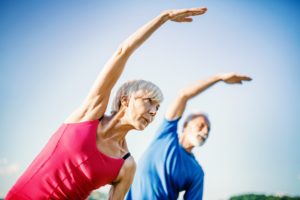 Research now shows how exercise training in older adults with obesity can help to preserve muscle mass, improve physical function, and reduce frailty. In aging Western populations, frailty is becoming a significant health concern.
Research now shows how exercise training in older adults with obesity can help to preserve muscle mass, improve physical function, and reduce frailty. In aging Western populations, frailty is becoming a significant health concern.
Exacerbated by obesity, frailty is not only a health concern but a major healthcare cost. The research reported in the journal Cell Metabolism shows that combining aerobic exercise and resistance training helps elderly obese patients preserve muscle mass and reverse frailty as they achieve weight loss.
Advertisement
A previous study done by Dennis T. Villareal, professor and geriatric endocrinologist at Baylor College of Medicine hypothesized that if resistance training accompanied weight loss, it could achieve the best results in improving physical function in older obese adults.
For this previous study, participants took part in a weight-management program and were randomly assigned resistance training, aerobic exercise, or a combination of both. It was shown that patients who completed these exercises had increased muscle protein synthesis and preserved muscle quality compared to control groups.
The researchers were surprised to find that combined resistance training and aerobic exercise improved cardiovascular fitness to the same extent as aerobic training alone. They also found that improved muscle strength was to the same extent as resistance training alone. But as for improvements in frailty, results were published in the New England Journal of Medicine in May 2017 showing that combined aerobic and resistance exercise resulted in the most considerable improvement in physical function and reducing frailty in older obese.
Molecular and Cellular Techniques
The part that became unclear was exactly how obese older adults benefitted from aerobic workout geared toward cardiovascular fitness combined with resistance training. In the research published in Cell Metabolism, molecular and cellular techniques were used to assess changes in muscle protein synthesis and myocellular quality. They were examined to find the mechanisms underlying in the obese older adults meant improvement in physical function and preservation of lean body mass.
For this new study, 47 of the original 160 in the previous test agreed to undergo muscle biopsies before and after six months of lifestyle interventions to test how the muscle tissue was affected. The participants were mixed gender with an average age between 69 and 72 years, and more than half were Hispanic/Latin.
Each participant was required to perform aerobic activities, including walking, treadmill, stationary cycling, and stair climbing. All participants were exercising at approximately 65 percent of their peak heart rate.
Advertisement
“Our findings indicated that despite negative energy balance from diet-induced weight loss, exercise training in older adults with obesity helps to preserve muscle mass, improve physical function and reduce frailty,” said Villareal.
The study concluded that participants muscle protein synthesis rate increase more with aerobic resistance and resistance training than in the control group. The combined aerobic-resistance exercise was also associated with lower expression of genes associated with muscle atrophy. It was also found that it had the best preservation of muscle growth regulators, which the researchers hypothesized could also play a role in promoting muscle mass preservation and improving physical function.
Villareal concluded the study saying, “In the elderly obese, combined aerobic and resistance exercise is superior to either mode independently for maintaining muscle mass during weight-loss therapy. Aerobic and resistance training is the most effective strategy and therefore is the best approach.”
